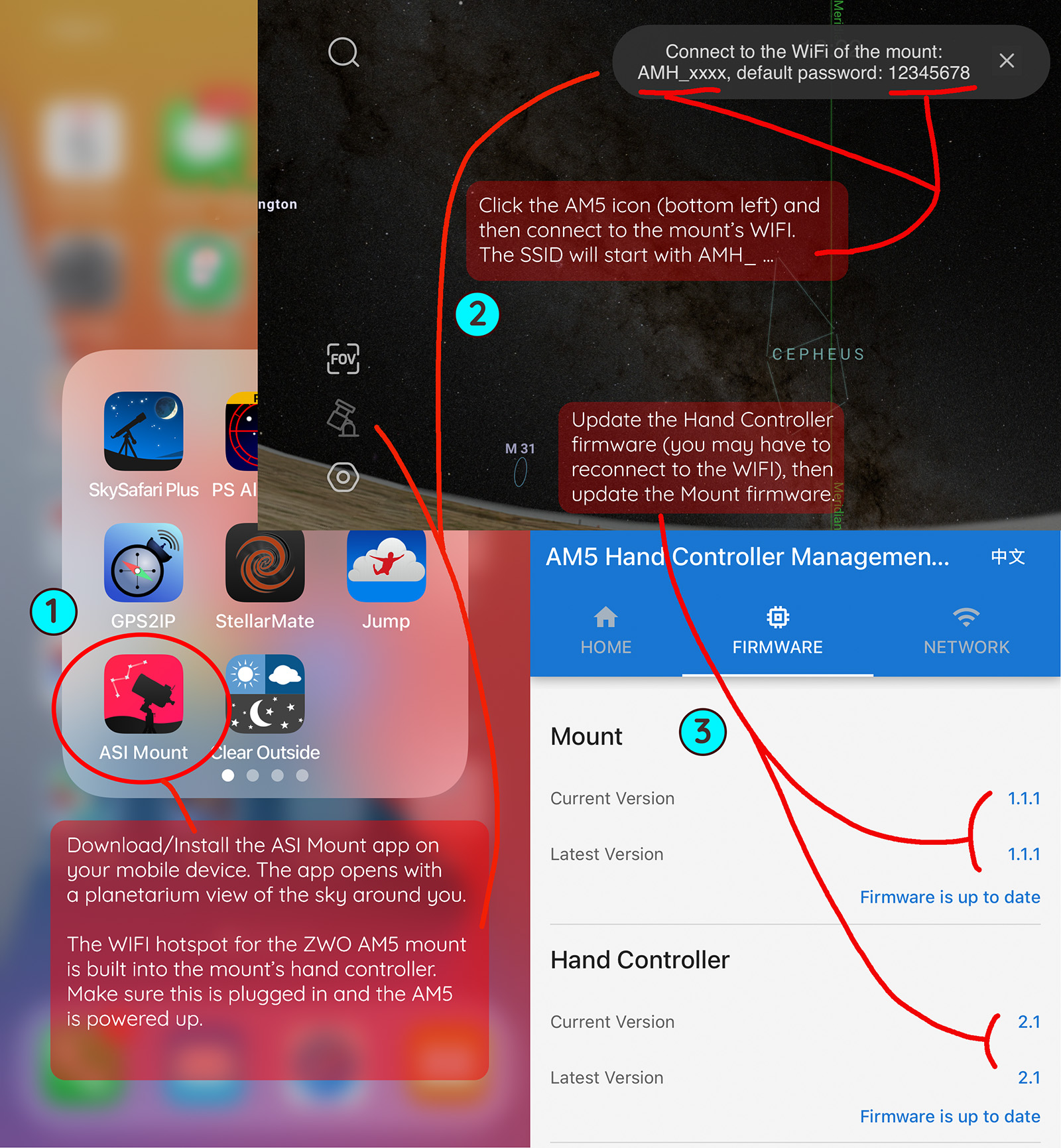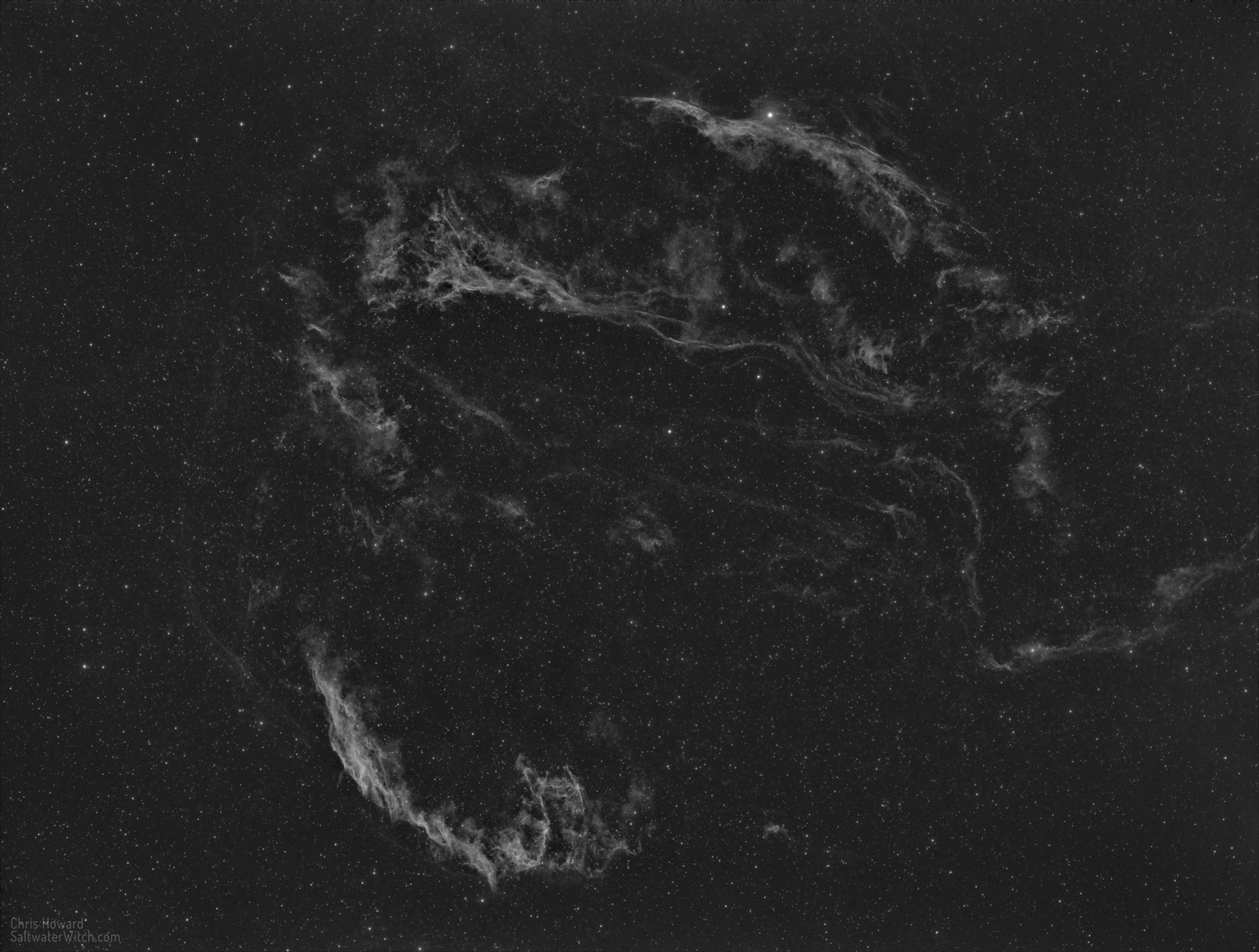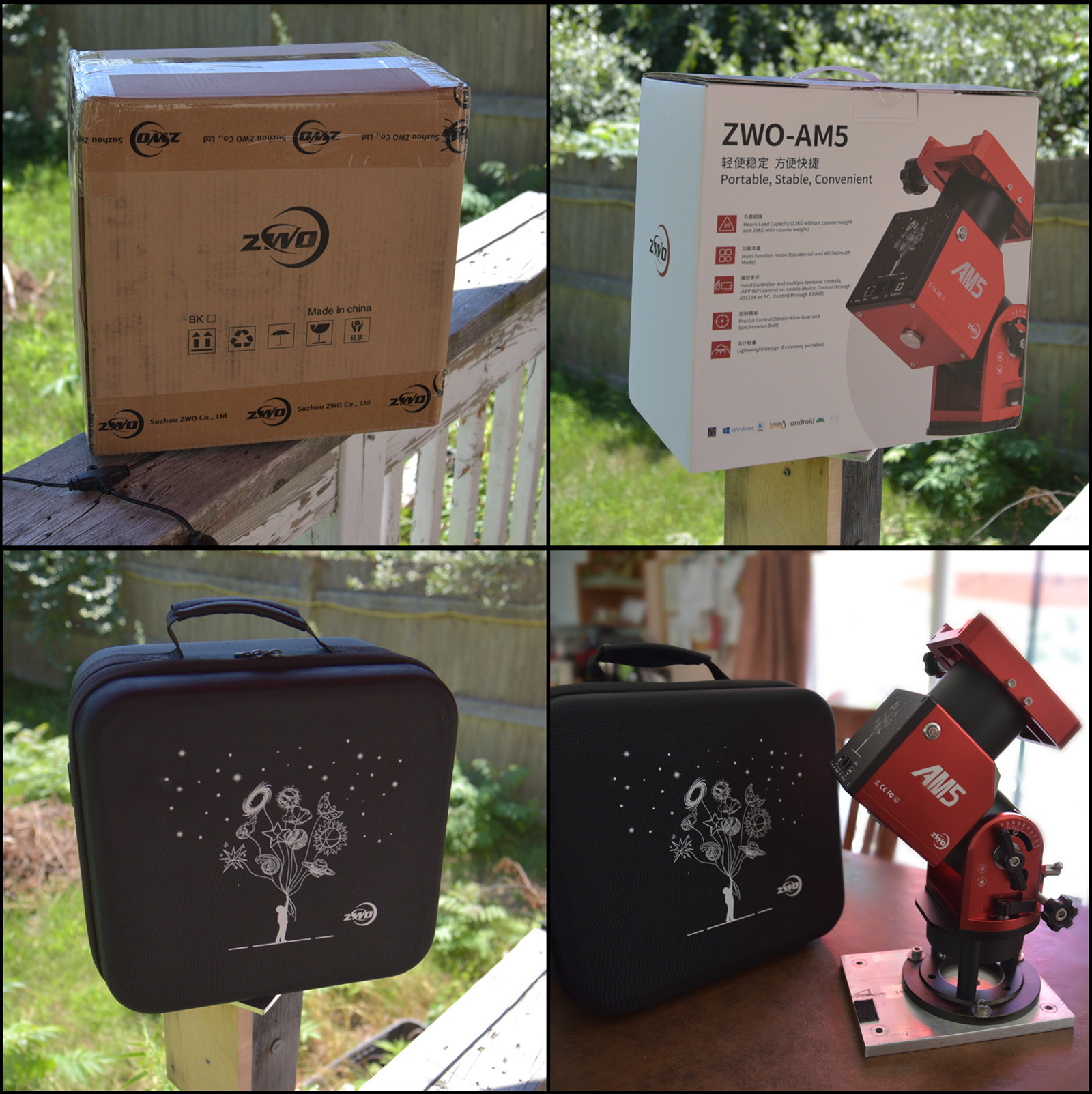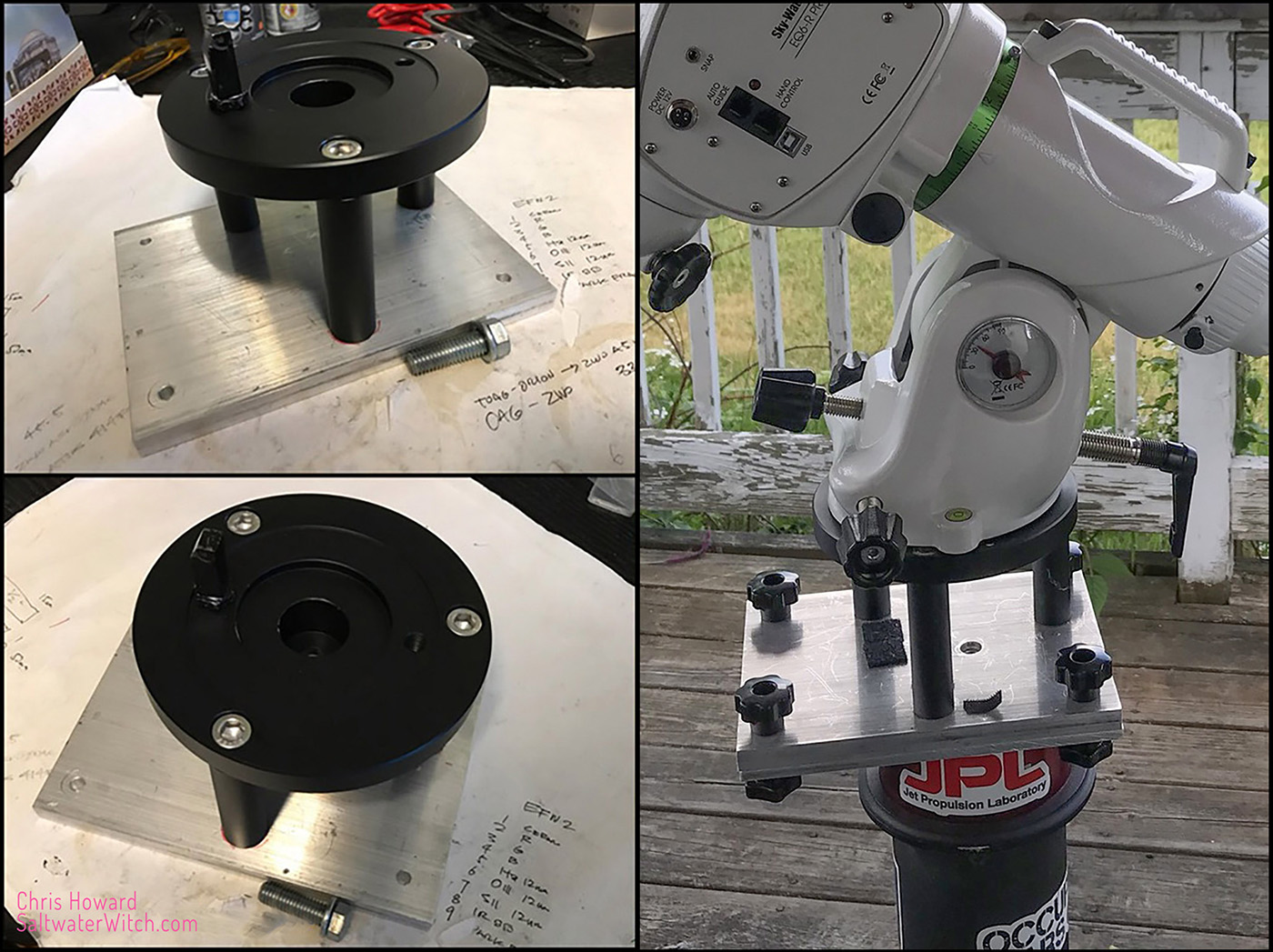Setting the Home Position for the ZWO AM5 Mount
Out of the box the DEC axis of my AM5 was a few degrees east, not lined up with the RA axis. There may be several ways to reset the home position, but I used the ASI Mount app on my phone. Plugged in the AM5 hand controller for wifi, connected to AMH_..., and when you tap the AM5 icon at the lower left, there's a "Home Position" in AM5 Settings. Tap "Calibrate" (it will move to what it thinks is home first), then you can adjust the DEC/RA with the buttons in the app (or maybe with the hand controller) and tap "Set" to save that position in the AM5.





Posted August 7, 2022
My first videos on the ZWO AM5 mount
The ZWO AM5 is here!
https://youtu.be/DE0lUUPakGE
First Light with the new ZWO AM5 mount
https://youtu.be/ckJPn3W-4Kw
Posted August 6, 2022
Update the ZWO AM5 Firmware
One of the first things I did after powering up the new mount, was to check the ZWO ASI Mount iPhone app, which instructs you to connect to the WIFI hotspot provided by the AM5 (built into the hand controller). I then upgraded to ZWO AM5 firmware version 1.1.1 and Hand Controller version 2.1. This took the mount from version 1.1.0 and the hand controller went from 2.0 I believe--so point release and minor release.

Posted August 5, 2022
ZWO AM5 First Light
First night out with the ZWO AM5 strain-wave gear/harmonic drive mount, and I am just stunned at how easy this mount is to setup, polar align, and run.
I swung the scope south to IC 4665—I just picked a nice star cluster in Ophiuchus, near the meridian in the south. I cleared calibration in PHD2, ran a new calibration, and then guided for an hour. I ran with defaults, 1 second exposures. Total RMS error through the session was between 0.4 and 0.7 arcseconds. And then I jumped into a bunch of 180 second subs of the Veil Nebula in Ha, watching the guide graph hovering in the high .4s and low .5s.
This was my first time setting up the AM5 for a night of imaging, and I think I was expecting something weird or some tech idiosyncrasy to appear, because that's the way it always is. New devices are just going to behave in ways you might not anticipate. This was my first experience positioning the mount, scope, and tripod, which I easily carried out to the deck with everything connected and ready to go—tripod, mount, scope, everything. Polar alignment in NINA is simple and automated, and the AM5 azimuth and altitude adjustments are smooth and easy to dial in. I had the mount aligned and ready to capture data in two or three minutes. Again, I'm a bit stunned at how uncomplicated this was—I was expecting something to go wrong, but the AM5 was just doing everything right, with accurate slewing, guiding, tracking, and I was sitting on the couch in the living room taking 180 second subs on the back deck.
Some surprises: I didn't expect the AM5 to be so compact and transportable—and I say this knowing my primary purpose for buying the mount was portability. It's crazy how easy this is to move around, and I think it comes down to the counterweights. They are a such a fundamental part of the system that it felt like I had missed something in setup, but after one night under the stars with the AM5, I'm thinking—unless you have a massive scope—counterweights should be a thing of the past. We have the technology. Why do we need them?
I did try out the new mount with Ekos/INDI and ran into an error connecting the AM5—an error setting the UTC Offset. I didn't dig into it, but it looks like a similar error—an old error—with the LX200 instruction set where Ekos is using a float and the mount is expecting an integer for the offset? Seems pretty minor to me, and easily fixable, so I will come back to Ekos soon as I have some time.
NINA/ASCOM worked flawlessly with the ZWO AM5, at least with my standard workflow: polar alignment, slewing, plate solving, guiding, focus, capture. I'm running Version 2.0 HF1 BETA015 on a fanless Windows 10 machine.
Finally, the skies weren't perfect, seeing was maybe a little above average, and the mount performed with those total RMS error numbers, .4, .5, .6 arcseconds. Amazing.


Here's 36 x 180-second subs, no calibration frames, stacked in DSS, stretched in Photoshop CC2022:

Posted August 3, 2022
Getting a new mount, a ZWO AM5
UPS just delivered my ZWO AM5 and I'm going to start on a list of tests and things I'm curious about. I know guiding is a clear one, and definitely going to run some guide tests, but what else? Here are four things I'm going to do. Anyone planning a long astro trip, or thinking about doing interesting things—even crazy things—with their AM5? Anyone building a micro-observatory? This seems like the perfect mount for it.
Adaptability
One of the first things I wanted to verify is the iOptron CEM/ZQ Tri-Pier Adapter with the ZWO AM5 mount. Looks good. (see the pic, bottom right). Over the years I have moved to one standard mounting point for my tripods and piers. I have a heavy-duty tripod, a small test pier ("winter pier") right off the back deck and my big pier about 30 meters from the house, in the backyard, and each has a 6 x 8 inch (152 x 203mm) mounting plate, drilled to accept four clamping crews. I have an aluminum plate on the mount side, and for the EQ6R-Pro and Orion Atlas I drilled and tapped holes to attach an iOptron Tri-Pier Adapter (#8036-TK), and for the CEM25p I used the #8036-25 Adapter. The CEM25p and the ZWO AM5 both use a standard 3/8 inch center mounting bolt, making this easy. No new adapters to build, and the new mount will fit with the big tripod and both piers. (I also have the ZWO TC40 Carbon Fiber Tripod for travel and I won't use the mounting plate). https://www.ioptron.com/product-p/8036.htm
Portability
I see a lot of ZWO AM5 owners focusing on large scopes and OTAs, how the mount handles a C925 or large refractor. I find this interesting, but my focus is entirely different, or maybe just narrower? I already have a mount for my larger scopes, the RC and 8" Newt. Portability is my top priority for the AM5, and the largest scope I will probably ever use with the AM5 is my William Optics GT81. My SpaceCat 51 is the main scope I plan to pair with the AM5 and TC40 Carbon Fiber tripod. One of the first things I want to accomplish is to get a full astro setup in one backpack or bag. I may have to do some camera backpack shopping.
Compatibility
I will be doing full imaging runs with NINA/ASCOM on Windows and Ekos/KStars/INDI on Linux. Although I have used a bunch of different astrophotography sequence and capture tools over the years, I seem to have settled on NINA and Ekos as the two that get the job done. Both are heavily supported, and they have a similar feature set--at least everything I need: polar alignment, sequencing, framing, full astro device support, multi-star guiding, and more. I don't have plans to buy an ASIAIR, but I totally appreciate the ingenuity that went into the design, I mean one tiny red aluminum box for everything, device management, imaging, power distribution, dew control, all driven through a phone or tablet app, that's genius, especially for a portable rig.
Non-Meridian-Flipability
Since balance is less of a concern with strain-wave gear mounts I want to try moving the scope forward, making it front-heavy, to the point where the camera and cables at the back clear the mount base at any rotation, effectively removing the need for a meridian flip. Has anyone tried this? I just ordered the Apertura Losmandy 14" Dovetail Plate from Highpoint, and the plan is to swap out the stock William Optics Vixen dovetail. We'll see if this works. The only downside I see is it will make changing cameras on the SpaceCat 51 more of a task because the EFW won't clear the longer dovetail plate. https://www.highpointscientific.com/apertura-essentials-losmandy-d-style-14-inch-universal-dovetail-plate-dup14




Posted July 30, 2022
Essential Tools & Products for Astrophotographers
I'm going to start a series of posts on this topic--"essential tools" to showcase a batch of tools, components, and other products and items I use to make this whole astrophotography journey easier. The first three are must-haves in my book--links below.
 1. Slip joint pliers with plastic inserts, designed for jewelry making I think. These come in handy when you need to tighten down the knurled metal screws for guide camera rings, or holding the guide cam shoe, or for tightening the tensioner on a rotator. These might work in cases where you want to tighten something just a bit more than you can with your fingers. But you also don't want to scratch the metal, paint, or plastic of whatever you're tightening. Just be careful because these are still regular pliers and you don't want to break anything.
1. Slip joint pliers with plastic inserts, designed for jewelry making I think. These come in handy when you need to tighten down the knurled metal screws for guide camera rings, or holding the guide cam shoe, or for tightening the tensioner on a rotator. These might work in cases where you want to tighten something just a bit more than you can with your fingers. But you also don't want to scratch the metal, paint, or plastic of whatever you're tightening. Just be careful because these are still regular pliers and you don't want to break anything.
2. I use nitrile gloves every time I'm changing filters, adjusting spacers or the OAG, and doing just about anything with my cameras. That's an obvious use, but I use these instead of the ring clamp tools I usually see as "must haves". I use these when I need to remove filters and spacers that are stuck, and the gloves allow you to unstick these without applying a lot of pressure, without squeezing one side of a spacer so much that the adjacent sides bow out and make it worse. They're even grippy enough to unstick those pesky super-slim M42 to M48 spacers.
3. Real gaffer tape, the expensive cloth stuff that will hold things down but won't leave any residue. Get the real thing, not the cheap stuff. I use this to hold cables together, to tape cables to the mount or the side of a camera. It's as permanent as you want it to be, holding whatever you need to hold until it's time to tear down your gear. Then it just peels away, and you can reuse it.
Non-marring Plastic Jaw Soft Touch Pliers
https://www.amazon.com/dp/B000ALF5EK
Nitrile Gloves
https://www.amazon.com/dp/B00GS8VGP6
Gaffer Tape
https://www.amazon.com/dp/B00ZRYP38I
Posted June 19, 2022
The moon is bright and the clouds are fast
So, I've been goofing around with hardware, updated NINA and plugins, getting ready for the next clear night. It's raining right now. I was looking at some narrowband data for Sharpless 2-199 (Soul Nebula) I captured late last year and reprocessed the Ha data. I am especially fascinated by the differences in depth and darkness between the background and the bands of dust and interstellar gasses that twist in front of the Soul Nebula, between us and the high-energy emission of the towering clouds of hydrogen beyond. Someone commented (I think on AstroBin) on another image of mine with similar properties—that I needed to bring up the black point, that the night sky is black. But why? Who says so? The data says the background isn't as dark as the dust, so why would I want to lose that difference?

Posted June 17, 2022
The Gradual Shift Toward Portable Astrophotography
I've been thinking about portability for a while, but of course that was on hold for a couple years. I'm thinking about it again. We have pretty decent night skies here, somewhere between bortle 4 and 5. On a clear night with good seeing, Andromeda is easily visible, the Milky Way isn't super obvious but you can see it--and it's easily captured with a 10-second exposure on any camera. We have great views of the circumpolar constellations, and there's so much to image in Cepheus, Cassiopeia, and Auriga. Just these three contain some of the most beautiful nebulae in the night sky. So, not bad at all, but being so far north (+43° Lat) we're also missing a lot of great nebulae around the galactic core.
For that, we will need to go south for some imaging.
Here's a shot of a nearly full moon through the trees. I also wanted to capture the moonlight through the glass insulators on the transmission lines. About a third of the way in from bottom left is the variable double star Antares (α Scorpii) in the constellation Scorpius. Antares is also part of the Rho Ophiuchi Cloud Complex, one of the most colorful and beautiful regions in the night sky. Unfortunately, what you see here, Antares at 20° is about as high as it will get in the sky. We're just too damn north.


